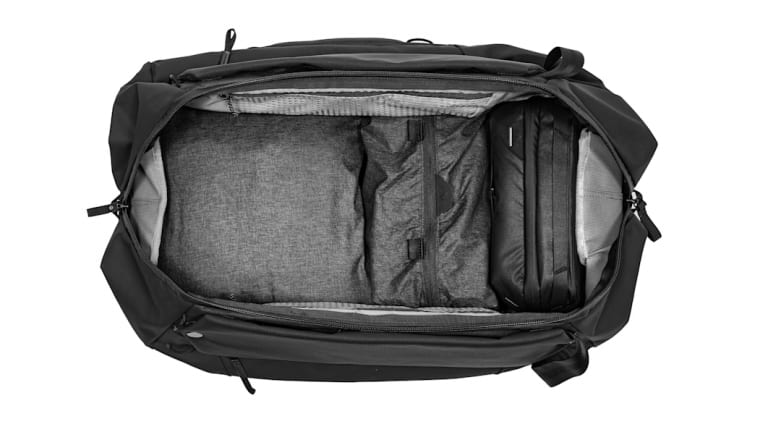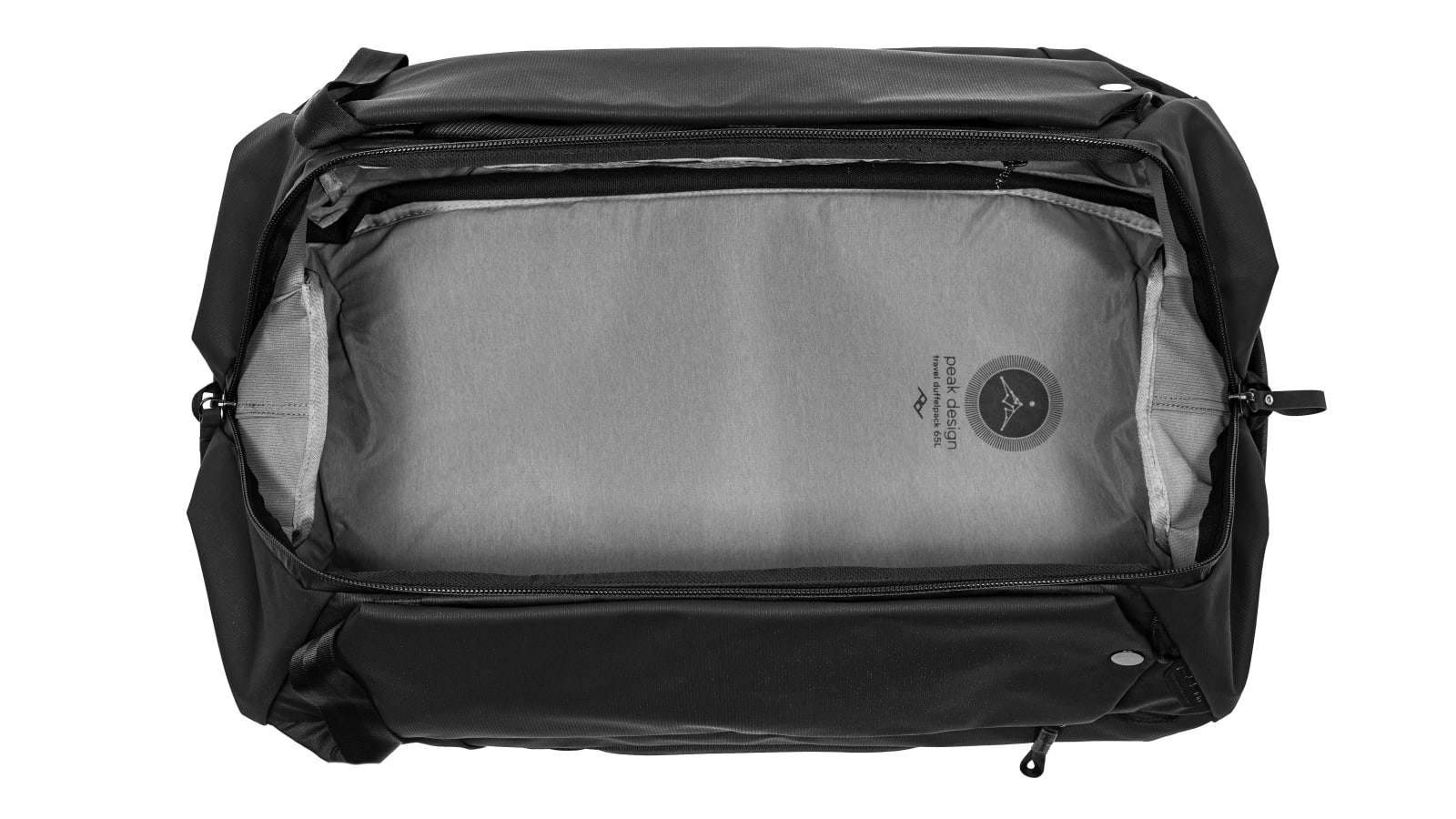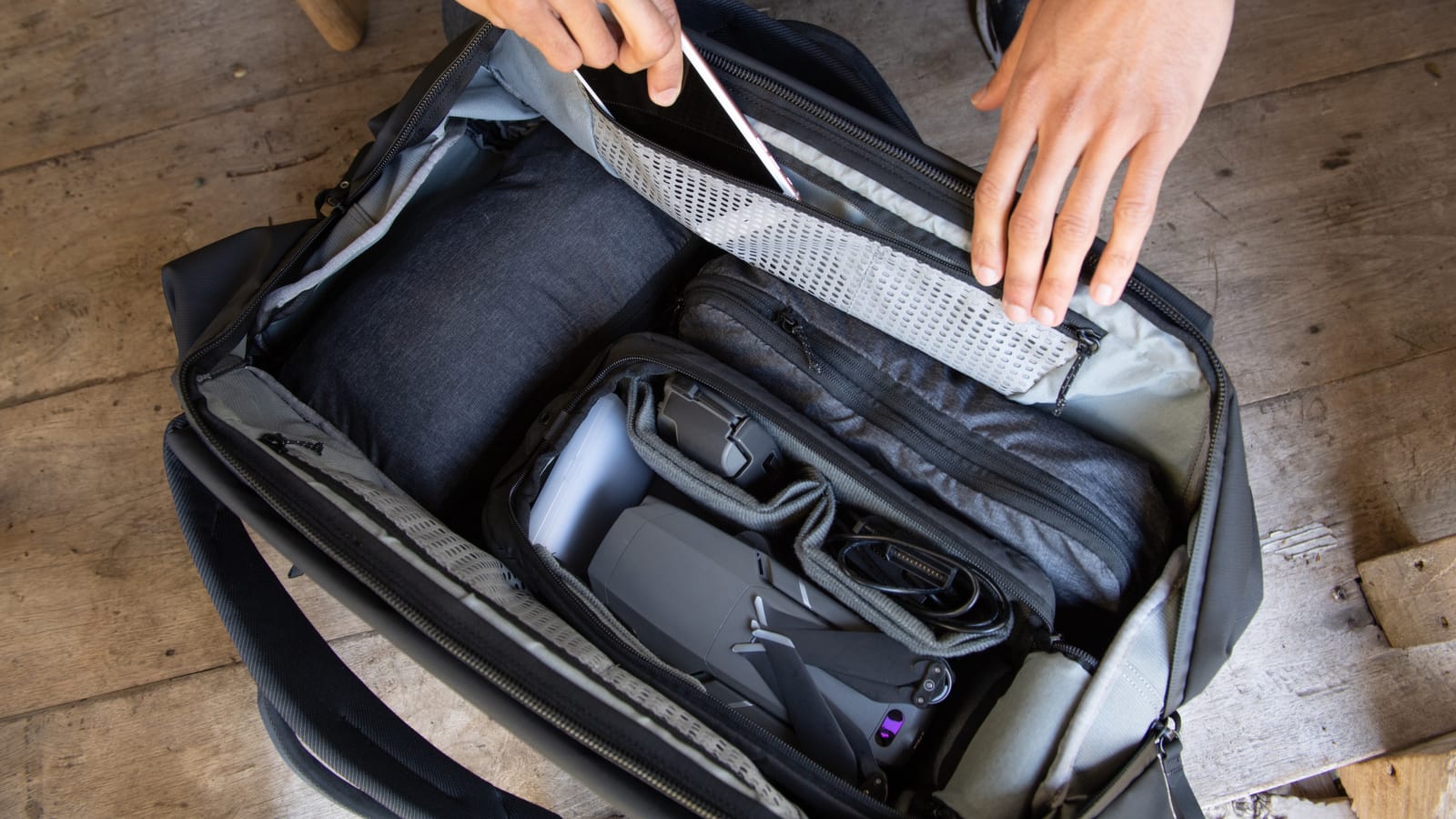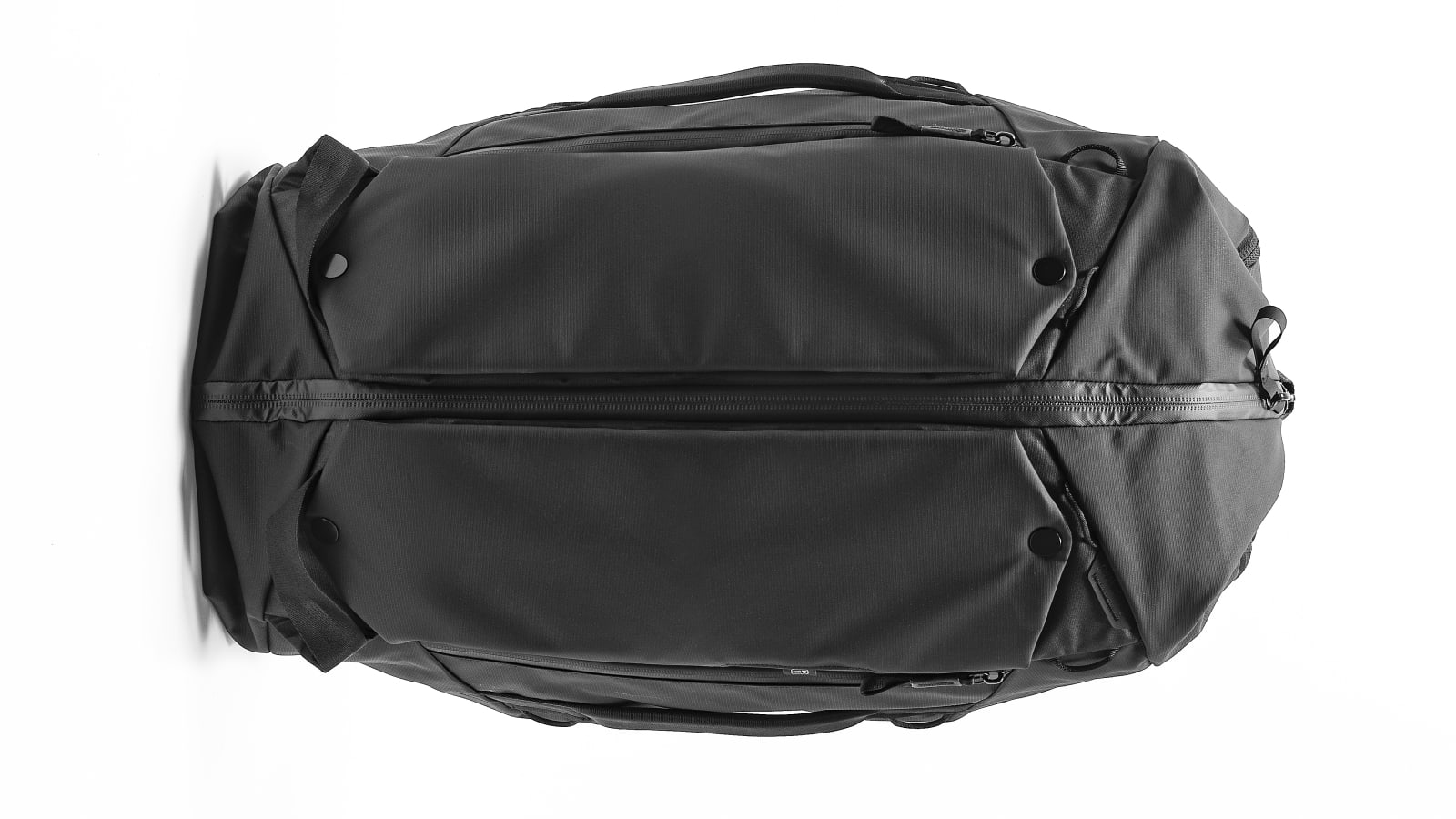Peak Design Travel Duffelpack 65L – $219
When it comes to travel bags, there are a few schools of thought. Some people prefer to have only one bag to take with them everywhere that can adapt to do everything, whether you’re going on a two-day visit with family or a two-week vacation to South America. Same bag, no reason to change. Others, like myself, prefer to have multiple options because a summer weekend camping in the Rocky Mountains requires quite a different setup than two weeks in Northern Michigan in the dead of winter. Is it less convenient to have multiple bags for multiple uses? Sure, sometimes. For the same reason that I avoid 3-in-1 jackets or restaurants that serve every dish you’ve ever heard of from sushi to tacos to pizza, I generally avoid “do-it-all” luggage, because while they may do everything pretty well, they usually aren’t best-in-class at any one thing.
The Peak Design Travel Duffelpack 65L is made for the former; those who want one bag for all of their travels. But is it the best backpack or best duffel out there?
Let’s start off with the good, of which there is quite a bit. First of all, the workmanship of this bag is great. This is the first Peak Design bag I have used and from the get go I was impressed with the quality of materials and craftsmanship. The exterior of the bag is made out of weatherproof 600D nylon and the exterior zippers are waterproof. The bottom of the bag is made from 900D nylon, which adds a bit of weight, but makes up for it in durability. Each handle has been firmly stitched on and it feels solid, whether you’re grabbing it from an overhead or off the baggage carousel.
To round out the exterior of the bag are two side pockets that can fit quite a bit of gear, two expansion zippers allowing the bag to grow from a 45 liter capacity to 65 liters, as well as stowable shoulder straps and a waist belt, for use when in backpack mode.
Open the Duffelpack up and you find that the interior color is light gray, much lighter than the jet black exterior of the bag we tested, making it easy to see everything that’s packed in the Duffelpack’s cavernous interior. This may seem trivial to anyone who hasn’t needed to find a phone charger or SD lens cap in a dimly lit room, but I assure you, it comes as a welcome design feature for me.
The interior is also where other items from the Peak Design ecosystem can come in handy. While there are a few interior zippered pockets, if you want to get the most out of your Duffelpack, you’ll likely want to pair it with some of Peak Design’s packing cubes or camera cubes, of which the Duffelpack fits four. This is where the Duffelpack shines, it turns into an incredibly versatile bag that can change drastically based on your trip. Weekend wedding across the country? Throw four of the Peak Design small packing cubes in there and you can easily fit a couple’s clothes in one bag. Video shoot in the mountains of Utah (which is what I used this for)? A small packing cube plus a large camera cube are right at home.
You do pay for that kind of convenience. While the Peak Design ecosystem is great, it is expensive. The Duffelpack itself has an MSRP of $219 and when you add four small packing cubes and a large camera cube to that, plus a tech pouch and a capture clip for your camera, you’re looking at a bag setup that can end up costing you well over $500.
$500 is a large amount of money for one piece of luggage, no matter how versatile, though just because you can spend the big bucks on the Peak Design ecosystem doesn’t mean you have to. It works just as well with off-brand, less expensive packing cubes. Plus, that large price tag does include a lifetime warranty, which, if you fly often, may end up paying for itself.
The large price tag isn’t the only hang up when it comes to the Duffelpack. For a bag that is marketed as a do-everything, there isn’t a great solution for the one thing I always carry with me: a laptop. A simple laptop sleeve would go a long way in protecting your computer and yet, while Peak Design does seem to have thought of nearly everything, this is a big thing to overlook.
Another issue is one of comfortability. In my latest use case I used the Duffelpack mostly as a backpack, with a fully loaded camera cube and a packing cube inside. I was able to fit everything in the backpack with ease, even when only at the 45 liter size, and yet, when the pack was full, it was cumbersome and heavy. The fold out waist straps routinely got in the way and the Duffelpack was not easy to take on and off.
Finally, the Duffelpack, full of its features and high end materials, is a heavy bag, even before you put anything in it. This seems to be a trend when it comes to Peak Designs bags. I didn’t go into this review thinking this would be a replacement for my ultralight backpack, but at nearly 4 pounds when empty, it is something worth mentioning. To be honest the weight isn’t a dealbreaker for me on its own, but something to be aware of.
Even with those gripes out of the way, my biggest complaint is that at 45L it isn’t a great backpack and at 65L it isn’t a great duffel. It’s just okay. And that’s the problem with a do-it-all bag. I’d rather purchase a 65L duffel and a 45L backpack from Peak Design that has all of the pros listed above and fewer cons than rely on one bag to do everything. Which, after you factor in all of the other Peak Design products you need to complete the package, this one bag doesn’t really do everything.
So that leaves us with two questions: is the Peak Design Duffelpack worth it? And is it a good all-in-one solution? Shortcomings aside, for someone who wants one bag for a variety of travels, the quality of materials and workmanship alone, not to mention the versatility of having a bag that can transform into multiple sizes depending on the use case makes the Duffelpack well worth the price. Tack the lifetime guarantee onto that and it becomes almost a no-brainer. Is it as versatile as having more than one bag? No, but I’ve yet to come across any one bag that is.
Peak Design Packing Cube – $29.95-39.95
Mentioned above, a packing cube is almost as important as the luggage you carry. They allow organization and make compressing a week’s worth of clothes into one duffle bag or carry-on much easier; gone are the days of sitting on top of your luggage trying desperately to zip it up.
The Peak Design Packing Cube in Medium, the size I tested, has a few features that you don’t find on all packing cubes that makes the higher price tag worth it. At first glance this bag doesn’t look like it has an 18-liter capacity, but once you start packing, that volume is there. While Peak Design claims it can hold twenty t-shirts, I can’t confirm, I didn’t have that many t-shirts in my closet to try it out. It did hold three button down shirts, three t-shirts, a pair of jeans, a pair of pants, socks, underwear and a light jacket with no problem at all. A compression zip allows all of this to be packed quite easily and then compressed down to half the size once everything is zipped up.
My favorite part of the Packing Cube design is the internal divider, which allows you to keep your clean and dirty clothes apart from each other, keeping you smelling fresh. With a price tag of $30 to $40, depending on which size you get, the Peak Design Packing Cubes may seem expensive at first, but with the quality materials, features that make it stand out from other packing cubes and a lifetime guarantee, the Peak Design Packing Cube is a must have for frequent travelers, especially those who already have one or more Peak Design products in their life.
Peak Design Tech Pouch – $59.95
The Peak Design Tech Pouch is engineering at its finest. Small enough to fit in your hand, yet strangely difficult to completely fill, this gear organizer reminds me a bit of Mary Poppins bag. On my latest trips I was able to fit two phone chargers, five camera batteries, a 35mm lens, two power banks, a handful of GoPro batteries, an audio recorder and multiple SD cards all in one pouch.
How much you can fit is one thing, but the fact that everything stayed organized is the impressive part. The outside of the Tech Pouch is covered in weatherproof 200d nylon canvas along with accompanying weatherproof zippers, ensuring that a little rain won’t ruin your day. There is one, smaller outside pocket that is perfect for a phone or passport, things that you need at the ready on travel days.
Inside the pouch is filled with compartments that are perfectly sized for batteries as well as a zippered SD card holder in the middle.
The Tech Pouch is my favorite Peak Design product I’ve used thus far. I’ve taken it on road trips into the mountains and fishing trips on high alpine lakes to keep my camera gear dry. That being said, the price tag at $60 is a tough pill to swallow. To make it a bit easier to think about, it comes with the same lifetime guarantee that other Peak Design products come with, so I never hesitate to jam it full of gear, knowing that if it literally bursts at the seams, they’ll stand behind their product.









